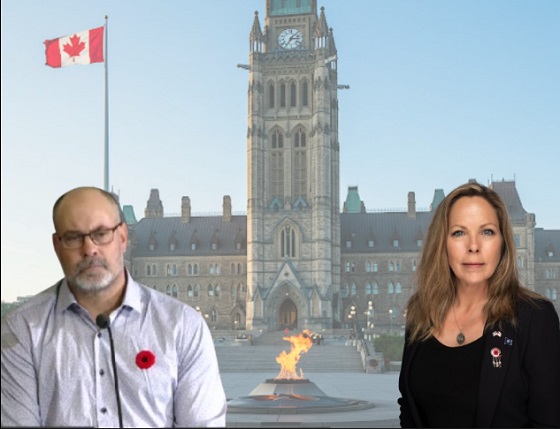National
Governor General gets $11,200 raise in 2024, third pay bump in three years

News release from the Canadian Taxpayers Federation
Author: Franco Terrazzano
The Governor General’s salary has increased by $60,000, or 20 per cent, since 2019.
Governor General Mary Simon received a $11,200 raise in 2024, her third pay bump since being appointed to the role in 2021, driving her salary for this year up to $362,800.
“Canadians are struggling to afford a jug of milk or a package of ground beef, so the government shouldn’t be rubberstamping another raise for the governor general,” said Franco Terrazzano, CTF Federal Director. “Can the government show Canadians how they’re getting more value, because the governor general’s paycheque just went up a thousand dollars a month.”
The Canadian Taxpayers Federation confirmed Simon’s salary and latest raise with the Privy Council Office.
“For 2024, the Governor General’s salary, which is determined in accordance with the provisions of the Governor General’s Act … is $362,800,” a PCO spokesman told the CTF.
The Governor General’s salary has increased by $60,000, or 20 per cent, since 2019. Meanwhile, the average annual salary among full-time workers is less than $70,000, according to Statistics Canada data.
Table: Annual Governor General salary, per PCO data
|
Year |
GG salary |
|
2024 |
$362,800 |
|
2023 |
$351,600 |
|
2022 |
$342,100 |
|
2021 |
$328,700 |
|
2020 |
$310,100 |
|
2019 |
$302,800 |
On top of the $362,800 annual salary, the governor general receives a range of lavish perks, including a taxpayer-funded mansion, a platinum pension, a generous retirement allowance, a clothing budget, paid dry cleaning services and travel expenses.
Former governors general are also eligible for a full pension, of about $150,000 a year, regardless of how long they serve in office.
Even though Simon’s predecessor, Julie Payette, served in the role for a little more than three years, she will receive an estimated $4.8 million if she collects her pension till the age of 90.
The CTF estimates that Canada’s five living former governors general will receive more than $18 million if they continue to collect their pensions till the age of 90.
Former governors general can also expense taxpayers up to $206,000 annually for the rest of their lives, continuing up to six months after their deaths.
In May 2023, the National Post reported the governor general can expense up to $130,000 in clothing during their five-year mandates, with a $60,000 cap during the first year.
Simon and Payette combined to expense $88,000 in clothing to taxpayers since 2017, including a velvet dress with silk lining, designer gloves, suits, shoes and scarves, among other items.
Rideau Hall expensed $117,000 in dry-cleaning services since 2018, despite having in-house staff responsible for laundry. That’s an average dry cleaning tab of more than $1,800 per month.
It’s also enough money to dry clean 13,831 blouses, 6,204 dresses or 3,918 duvets, according to the prices at Majestic Cleaners in Ottawa.
In 2022, Simon’s first full year on the job, she spent $2.7 million on travel, according to government records obtained by the CTF.
Simon’s travel has sparked multiple controversies, including her nearly six-figure in-flight catering tab during a weeklong trip to the Middle East, and her $71,000 bill at IceLimo Luxury Travel during a four-day trip to Iceland.
In the aftermath of the scandals, a parliamentary committee recommended a range of reforms to the governor general’s travel budget, including a regular review of the cost-effectiveness of trips, a reduction in the size of delegations and less spending on snacks and drinks.
“The platinum pay and perks for the governor general should have been reined in years ago,” Terrazzano said. “A serious government would mandate the governor general’s office be subject to access-to-information requests, cut all international travel except for meetings with the monarchy, end the expense account for former governors general, reform the pension and scrap the clothing allowance.”
2025 Federal Election
Mark Carney: Our Number-One Alberta Separatist

By George Koch
While envisioning Carney as an intentional saboteur is probably the stuff of parody, one can seriously state that were he trying to bring about Canada’s destruction, he could hardly fashion a more devilishly effective policy platform, nor a more toxic mode of practising federalism. If he doesn’t alter course dramatically as Prime Minister, he’ll be practically goading Alberta to launch a bid for independence.
You probably need no reminding of how cringeworthy Mark Carney’s professions of devotion to Alberta – “I grew up here” – or his “regular guy” stunts gliding shakily around the ice in an Oilers jersey have been. After rolling our eyes, most of us Westerners instead focused on the Liberal leader’s policies, which would devastate Canada from coast to coast but most particularly the energy-producing West – and which some tried to warn would once again
enflame Alberta separatism. The state-subsidized Laurentian media, however, scoffed at these potentially nation-cleaving risks.
But what if Carney is being true to his word in both cases? What if the Oxford PhD and former governor of both the Bank of Canada and Bank of England is a loyal Albertan to his very bones, his carefully curated persona as bespoke globalist climate-cult prophet an elaborate illusion; but that, at the same time, his policies are intended to wreck Canada, thereby rekindling a Prairie fire of separatism? Imagine that this is precisely Carney’s plan.
Imagine, in other words, that Mark Carney is some kind of Manchurian Candidate or 21 st century Scarlet Pimpernel, a deep-cover sleeper agent, sent East into the very heart of darkness – Ottawa – by a cabal of crafty Albertans intent on gaining independence. His secret mission: to worm his way deep inside Laurentian Canada, gaining the trust of Canada’s immensely arrogant yet not terribly bright Eastern elites, becoming both the manager of an enormous multi-billion-dollar investment fund and the secret right-hand-man of the Prime Minister himself, instructed there to wait until the right opportunity arrived.
And in January 2025, with Justin Trudeau’s resignation, that moment was at hand. Carney was given his ultimate mission: to gain the leadership of the Liberal Party of Canada and then to win electoral office with the mission of so misgoverning Canada as to bring about its dissolution and trigger the separation of Alberta.
This might all seem a bit far-fetched, possibly even satirical. But seen this way, certain strange things do begin to make some semblance of sense. Not just Carney’s weird lines about Alberta, but the sheer, wanton destructiveness of his policies.
Think of the $225 billion in federal deficits Carney intends to run over the next four years. Or his hapless responses to U.S. President Donald Trump. His unwavering advancement of the net-zero madness, capable of wrecking Canada’s economy from coast to coast. The equanimity towards Communist China.
Closer to (our) home, the contemptuous dismissals of Premier Danielle Smith who, as premier of Canada’s last remaining truly productive province, is someone whom logic and self-interest would suggest Carney should keep on his side. Instead, he ignores Smith and on the key issues of approving new energy pipelines and ditching the oil and natural gas emissions cap, he speaks out of both sides of his mouth.
While envisioning Carney as an intentional saboteur is probably the stuff of parody, one can seriously state that were he trying to bring about Canada’s destruction, he could hardly fashion a more devilishly effective policy platform, nor a more toxic mode of practising federalism. If he doesn’t alter course dramatically as Prime Minister, he’ll be practically goading Alberta to launch a bid for independence.
Creating a Manchurian Candidate/Scarlet Pimpernel named Mark Carney would be nefarious, devious, conspiratorial and downright evil. The way the CBC, Globe and Mail and various Liberal/NDP/Bloc politicians tell it, of course, there’s no shortage of such people in Alberta. So is it truly impossible? Or perhaps simply moot, Carney’s stated policies being so destructive as to render them indistinguishable from those of a spy.
Post-election, what would signal a looming crisis of national disunity? It’ll begin with the predictable political noise: soaring poll results for Alberta separatism, calls from surprising quarters – such as formerly-complacent corporate leaders – that the province get out from under Ottawa, perhaps a burgeoning independence party challenging Smith’s governing UCP.
There’ll be even more intense courtroom efforts by Alberta to resist federal overreach and unconstitutional laws and policies. Increasingly pointed warnings from Smith that the political situation could spiral out of control. Frequent invocation of Alberta’s Sovereignty Act to deflect abusive federal actions; perhaps even open defiance of the most illegitimate of these.
Alongside that, increasingly concerted measures to prepare the province of Alberta to become the self-governing nation of Alberta. The until now incremental steps to decouple Alberta law enforcement from the RCMP will be sharply accelerated. The so-far somnolent plod to unshackle Albertans from the bloated, under-performing and increasingly woke-driven Canada Pension Plan will be rattled into a sprint.
Alberta’s Department of Finance will be tasked with setting up a branch to start collecting – and keeping – federal taxes. Reports might trickle out of Alberta mapping the outlines of an intelligence service and armed defence force. Emissaries will be quietly sent to pitch First Nations that they’d be better off as Albertans.
Among the world’s currently 195 recognized states, an independent Alberta would have:
The 52 nd largest global economy as measured by its 2024 GDP of $351.4 billion (US$256.2 billion);
A population (4.96 million as of January 2025) larger than those of 70 other sovereign nations;
A land area greater than those of 155 other nations;
Per-capita GDP (US$53,834 in 2024) among the world’s 20 most prosperous nations; and
A GDP sufficient to finance a military approximately as large and effective as Norway’s, a full NATO ally that already flies the F-35 stealth fighter.
In short, Alberta would be as politically and economically viable as Norway, Finland, Denmark, Sweden, New Zealand and other small but advanced countries.
Note too that these already-favourable statistics assume “all other things remain equal.” But all of those numbers would improve once the great financial anvil of Ottawa was lifted from around Alberta’s neck. This in turn would enable large cuts to income taxes, pension and EI premiums, and other fiscal burdens, sending Alberta soaring far beyond any Canadian province and making it competitive with the best-run U.S. states.
Meanwhile the under-performing remnants of Canada would be cast adrift to sink further towards Third World status. “Canada” would drop several rungs on the ladder of global economies and world population. The more appropriately renamed “Laurentia” might be sent scuttling out of the G7. An impoverished Quebec might depart in a huff as well.
It would take a man of almost preternatural internal fortitude, unquenchable zeal and unwavering focus to bring about such an evident calamity, throwing the fortunes of tens of millions of mostly innocent Canadians onto the flaming pyre for the good of a few million Albertans. But setting aside all satire: with his widely predicted electoral majority in hand, Prime Minister Mark Carney will have free rein to impose his devastating array of policies, systematically undermining the economy, Canadians’ remaining sense of nationhood, individual hope and social stability.
I doubt any free-thinking citizen of Alberta would believe the outlandish tale of how Carney wrecked Canada in order to bring about the glory of independence. And so in a final and bitter irony, ostracized and alone, the man who sacrificed everything for his beloved province –career, reputation, perhaps even his very soul – will not only be shunned from running in the first Presidential Election of the Republic of Alberta, he will likely be denied even the ceremonial role of Ambassador to the impoverished, embittered remnants of Canada, Laurentia.
The original, full-length version of this article was recently published in C2C Journal.
George Koch is Editor-in-Chief of C2C Journal.
2025 Federal Election
Nine Dead After SUV Plows Into Vancouver Festival Crowd, Raising Election-Eve Concerns Over Public Safety

 Sam Cooper
Sam Cooper
In Vancouver, concern about public safety — particularly assaults and violent incidents involving suspects previously known to police — has been a longstanding civic and political flashpoint
In an evolving mass-death investigation that could have profound psychological and emotional impacts on Canada’s federal election, Vancouver police confirmed Sunday that nine people were killed Saturday night when a young man plowed a luxury SUV through a festival block party in South Vancouver, leaving a trail of instant deaths and horrific injuries, with witnesses describing convulsing bodies and wounded toddlers in the aftermath.
The driver, a 30-year-old Vancouver resident known to police, appeared to be shaken and apologetic, according to eyewitness accounts and video from the scene. Authorities stated the case is not being treated as terrorism.
Late Saturday night, Vancouver police confirmed at a news conference that the man, who was known to police “in certain circumstances,” had been arrested.
The incident occurred around 8:14 p.m. during the annual Lapu Lapu Festival, a celebration of Filipino Canadian culture held near East 41st Avenue and Fraser Street. Thousands of attendees had packed the area for cultural performances, food stalls, and community events when the luxury SUV entered the closed-off area and accelerated into the crowd. Photos of the vehicle, with its doors ajar and a crumpled front end, indicate it was an Audi Q7 with black tinted windows.
In Vancouver, concern about public safety — particularly assaults and violent incidents involving suspects previously known to police — has been a longstanding civic and political flashpoint. Saturday’s tragedy sharpened those anxieties, potentially influencing the attitudes of undecided voters in a federal election that has focused on social disorder and crime framed by the Conservative side, with the Liberal frontrunners countering that firmer sentencing laws would undermine Canada’s Charter of Rights.
Witnesses to Saturday’s tragedy described scenes of chaos and terror as the SUV slammed into festival-goers, accelerating through the crowd.
“I thought it was fireworks at first — the sounds, the screams — then I saw people flying,” one witness told reporters on the scene.
Authorities have launched a full criminal investigation into the suspect’s background, including previous interactions with law enforcement.
The tragedy unfolded during the final, high-stakes weekend of Canada’s federal election campaign, throwing public safety and political leadership into sharp relief.
On Saturday night, before news of the Vancouver incident broke, Conservative leader Pierre Poilievre posted a message on X at about 10 p.m., declaring, “This election comes down to one word. Change. Our Conservative plan will bring home an affordable life and safe streets — For a Change.”
Meanwhile, Liberal leader Mark Carney, campaigning in the Greater Toronto Area, posted at roughly the same time, “Dropped in on dim sum today in Markham. The best part of this campaign has been meeting Canadians in their communities — and hearing how excited they are about our future.”
As the scale of the tragedy became clear, both leaders shifted sharply in tone.
Poilievre posted again around 1 a.m. Sunday, writing, “I am shocked by the horrific news emerging from Vancouver’s Lapu Lapu Day Festival tonight. My thoughts are with the Filipino community and all the victims targeted by this senseless attack. Thank you to the first responders who are at the scene as we wait to hear more.”
Carney, who had posted shortly before midnight that, “We don’t need anger. We need to build,” followed with a direct statement on the Vancouver attack around 2 a.m. Sunday morning, writing, “I am devastated to hear about the horrific events at the Lapu Lapu festival in Vancouver earlier this evening. I offer my deepest condolences to the loved ones of those killed and injured, to the Filipino Canadian community, and to everyone in Vancouver. We are all mourning with you.”
Online, the tragedy quickly reignited concerns about violent crime, bail, and the rights of offenders — issues that have increasingly polarized Canadian political debate.
In response to Carney’s statement, a comment from an account named Willy Balters reflected the growing anger: “He’ll be out on bail by morning right?”
Another commenter, referencing past political controversies over judicial reform, posted to Carney, “You stood behind a podium and declared murderers’ Charter Rights can’t be violated.”
The raw public sentiment mirrored broader criticisms that Canada’s criminal justice system — and its perceived leniency toward repeat offenders — has failed to keep Canadians safe.
Just days prior, a different incident tapped into similar public anger. B.C. Conservative MLA Elenore Sturko posted, “A visitor to Vancouver was brutally attacked by a man only hours after he was released on bail for assaulting police and uttering threats. @Dave_Eby — is this the kind of welcome visitors to FIFA will have to look forward to? BTW, this violent man is out on bail AGAIN!”
That incident continued to draw heated social media on Sunday, with David Jacobs, a well-known conservative-leaning commenter, posting, “A man, while out on bail for assaulting a peace officer, violently assaulted a woman. He’s out on bail again. The Liberals put criminal rights far ahead of victim rights and community safety. Stop the insanity. Vote for change!”
The Bureau is a reader-supported publication.
To receive new posts and support my work, consider becoming a free or paid subscriber.
Invite your friends and earn rewards
-

 Alberta1 day ago
Alberta1 day agoGovernments in Alberta should spur homebuilding amid population explosion
-

 armed forces2 days ago
armed forces2 days agoYet another struggling soldier says Veteran Affairs Canada offered him euthanasia
-

 International1 day ago
International1 day agoHistory in the making? Trump, Zelensky hold meeting about Ukraine war in Vatican ahead of Francis’ funeral
-

 Alberta1 day ago
Alberta1 day agoLow oil prices could have big consequences for Alberta’s finances
-

 Business1 day ago
Business1 day agoIt Took Trump To Get Canada Serious About Free Trade With Itself
-

 conflict2 days ago
conflict2 days agoWhy are the globalists so opposed to Trump’s efforts to make peace in Ukraine?
-

 2025 Federal Election1 day ago
2025 Federal Election1 day agoCarney’s budget is worse than Trudeau’s
-

 C2C Journal22 hours ago
C2C Journal22 hours ago“Freedom of Expression Should Win Every Time”: In Conversation with Freedom Convoy Trial Lawyer Lawrence Greenspon







